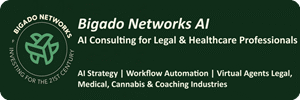In the realm of high-trust, high-stakes professions like medicine and law, there exists a deeply ingrained standard: do not treat the unknown. Whether examining a patient with ambiguous symptoms or reviewing a complex legal dispute, practitioners know better than to act on assumption. Every decision must be grounded in verified information—labs, imaging, testimony, precedent. Precision is everything. And yet, when it comes to adopting artificial intelligence into their practices, many professionals overlook this principle entirely. They jump to solutions before defining the problems, introducing complexity before understanding the terrain. It’s a mistake with high costs and even higher opportunity loss.

Artificial intelligence, for all its promise, is not a plug-and-play solution. It’s not a one-size-fits-all answer to inefficiency, burnout, or rising costs. Rather, AI is a sophisticated toolset that must be selected, customized, and integrated with the same thoughtfulness and care a physician uses when prescribing medication—or a litigator uses when crafting a closing argument. It demands context. And context only comes from proper assessment.
What is an AI assessment in this context? It is not a sales pitch, nor is it a shallow survey filled with buzzwords. A true assessment is a diagnostic engagement. It asks detailed questions about your workflows, systems, people, and problems. It evaluates the condition of your data and the adaptability of your culture. It investigates what technologies are in use, what goals are being pursued, and what bottlenecks are consistently slowing progress. It seeks to answer one core question: Are you ready for AI—and if so, where and how should it be applied?
Without this first step, even the most promising technology risks becoming wasted effort. In fact, many failed AI implementations can be traced not to bad tools, but to poor planning. For example, consider a mid-sized law firm that invests in an AI contract review platform. It promises to scan and flag risk clauses in minutes—a task that might otherwise take paralegals hours. But within weeks, the software goes unused. Why? Not because it didn’t work, but because the firm’s documents were stored inconsistently across Dropbox folders, email chains, and individual desktops. The software couldn’t locate or access the materials it was designed to improve. Without an assessment, this architectural oversight went unnoticed—until money and morale were already lost.
In medical settings, the missteps may be even more consequential. Imagine a clinic eager to reduce charting time. They invest in a voice-to-text AI that promises to convert doctor-patient conversations into structured SOAP notes. On paper, it’s a dream. But after implementation, physicians complain that the system struggles with medical terminology, or doesn’t sync correctly with their EHR. IT support becomes overwhelmed, and some staff revert back to manual dictation. Again, the failure isn’t AI—it’s misalignment. An assessment could have identified the vocabulary limitations, integration gaps, and user readiness issues long before the money was spent.
When we conduct assessments at Bigado Networks, we often find that what clients think they need is not what will actually help them. A clinic may believe they need AI to schedule patients more efficiently, when the real issue is that their intake forms are outdated and don’t capture key variables like insurance type or visit reason. A legal practice may want AI to help with legal research, when what’s really needed is a better case management system that organizes files and tags documents properly. In both scenarios, the best solution is only clear after a full analysis. Skipping that process is like skipping a physical exam and ordering surgery based on a hunch.
Furthermore, assessments uncover obstacles that no software alone can fix. One of the most common challenges we encounter in both medical and legal settings is cultural resistance. Professionals in these fields are often skeptical of new technologies, and with good reason. They operate in environments where mistakes are costly and trust is paramount. AI feels opaque, unpredictable, even threatening to some. During an assessment, we interview not just leadership, but frontline users—the doctors, nurses, attorneys, paralegals, and administrative staff who will be interacting with these systems every day. We ask about their concerns, their frustrations, their hopes. We listen. We observe where the friction lies—not just in the software, but in the psychology of the workplace.
These human insights are invaluable. A medical practice may technically be AI-ready from a systems standpoint, but if the physicians feel that AI compromises the sanctity of the doctor-patient relationship, implementation will fail. A legal team may embrace automation on the surface but resist adopting it because they believe it will devalue their expertise. An effective AI strategy must include not only technical solutions, but communication strategies, training plans, and change management protocols. That’s the difference between adoption and abandonment—and it begins with assessment.
Assessments also protect clients from unrealistic expectations. AI is powerful, but it is not all-powerful. It cannot replace a lawyer’s judgment or a physician’s bedside manner. It cannot mediate office politics, restructure broken hierarchies, or magically make outdated systems interoperable. It cannot eliminate HIPAA or ABA compliance requirements. What it can do, when properly aligned, is reduce repetitive tasks, surface insights faster, enhance consistency, and enable professionals to spend more time on complex or human-centric work. But in order to set these expectations clearly, you must start with a grounded understanding of your current state—and that requires an assessment.
Some clients resist this step, seeing it as a delay or a cost center. But the reality is, an assessment often pays for itself several times over. By avoiding false starts, incompatible tools, or misdirected implementation strategies, practices can save tens of thousands of dollars—and months of frustration. Even more importantly, they can accelerate their learning curve. When an assessment reveals high-impact opportunities (such as automating appointment reminders or streamlining document routing), organizations can begin reaping the benefits of AI quickly and confidently. These “quick wins” build momentum, reinforce team trust, and lay the groundwork for deeper transformation later.
Over time, as clients become more fluent in AI, the benefits multiply. The doctor who once bristled at voice dictation now reviews auto-generated summaries with ease. The attorney who doubted machine learning tools now uses them to prepare briefings in half the time. But none of this happens by accident. It happens through careful staging, clear communication, and a deep understanding of what’s broken, what’s possible, and what’s truly valuable.
The assessment process also creates lasting documentation. The findings from an AI readiness assessment can be used as a baseline for future initiatives, a communication tool for stakeholders, or even a strategic planning asset for the next 12 to 24 months. It becomes a record of what was learned, what was decided, and what still needs work. For practices that must demonstrate due diligence—such as those navigating HIPAA, SOC 2, or other regulatory frameworks—this documentation adds a layer of governance and accountability to their AI journey. It shows that changes were made not on impulse, but on evidence.
Ultimately, an AI assessment is not just about the technology—it is about the business. It is about people, process, and purpose. It is a mirror that reflects how your practice functions, and a guide that shows how it might evolve. For medical and legal professionals who are used to operating under pressure, it offers a rare moment of pause. A chance to step back and ask: What are we really trying to achieve? Where are we wasting time? Where are we duplicating effort? Where are we losing trust?

The answers to these questions are not always easy. But they are always illuminating. And they lead, more often than not, to better decisions, stronger teams, happier clients—and yes, smarter systems.
So before you digitize, diagnose. Before you automate, assess. Before you say yes to the promise of artificial intelligence, take a good look at the truth of your business. It’s the first step not just to using AI—but to using it well.
Need help assessing your medical or legal practice for AI readiness?
At Bigado Networks, we bring years of experience in both regulated industries and cutting-edge technology. Our AI Readiness Assessments are custom-tailored to your practice, your workflows, and your goals. Let’s start by understanding where you are—so we can get you where you want to go.
📞 Schedule your personalized consultation today
📩 Email us directly at info@bigado.com
🧠 Intelligent systems begin with intelligent planning.
